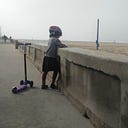The CA Air Resources Board (CARB) in 4 Minutes
This article describes the formation and current operations of CARB. It is part of a series that provides short guides to different governmental transportation organizations in LA and CA.
Formal Name: California Air Resources Board
Year Formed: 1967
Budget: $1.5 billion
Staff: 1,550 positions
What the CARB Does: Develops programs to protect air quality and fight climate change.
CARB is not focused exclusively on transportation, but since how we get around plays a huge role in the the quality of our air, CARB is a major player in transportation- particularly with respect to cars and trucks.
Unlike Caltrans and the CTC, the Air Resources Board is not under the purview of the California State Transportation Agency, which oversees all the other departments related to transportation. Rather, CARB falls under the umbrella of the state’s Environmental Protection Agency.
History
Here is a very brief history of how CARB was formed over three decades, mostly taken from their website:
- The 1940’s: The widespread popularity of cars in Los Angeles was beginning to make the air terrible. In response, people in the region created the first formal governmental entity to tackle the issue: the LA County Air Pollution Control District.
- The 1950’s: State officials in Sacramento began tackling the air quality issue during this decade after the pioneering work of Dr. Arie Aagen-Smit of CalTech showed a clear link between auto emissions and smog. The Bureau of Air Sanitation was formed within the California Department of Public Health in 1955, and this body would set the first air quality standards that identified pollution levels that could endanger the health of sensitive groups of people.
- The 1960’s: The California Motor Vehicle Pollution Control Board was created in 1960 to regulate tailpipe emissions. In 1967, California Air Resources Board (CARB) was formed through a merger of the Bureau of Air Sanitation and the California Motor Vehicle Pollution Control Board, thus bringing the link between air quality and auto emissions squarely under the supervision of one organization.
Also in 1967, Congress passed the Federal Air Quality Act of 1967, which gave California the ability to “set more stringent air quality rules due to California’s unique geography, weather and expanding number of people and vehicles.”
This waiver has lasted several decades and allowed California to become a national leader in fostering both emissions technologies and regulatory frameworks that reduce air pollution and fight climate change. It is this waiver that the Trump administration is now trying to undo, and which the state of California is challenging in court.
Current Operations
At the present moment, the list of programs run by CARB as it fights on multiple environmental fronts is a so wide-ranging that it borders on surreal- see the full list here.
Unfortunately, the official CARB website isn’t very clear on outlining its main programs clearly for the layperson, but you can get a general overview based on its 2018–19 budget.
CARB slots most of its budgeted programs (95%) into three broad categories.
The largest program is the Climate Change program (43% of its budget). In recent years the transportation sector replaced power plants as the biggest source of greenhouse gas emissions (see graphic below), and CARB has a mandate from Assembly Bill 32 to lead a reduction of greenhouse gases.
The second largest CARB program is devoted the Mobile Sources program (30% of the budget), which is mostly coming up with ways to make cars pollute less. There are a whole bunch of different CARB programs to regulate polluting vehicles, make fuel sources cleaner, and incentivize non-polluting vehicles.
The third largest CARB program is the Community Air Protection Program (CAPP) that oversees programs to reduce air pollution in California’s most burdened communities (23% of the budget). Pollution tends to be higher in lower-income communities and communities of color, and the initiatives within this larger program try to remediate this disproportionate impact. Here is a map of the state’s communities that fall within this program:
CARB headquarters are at the state capital in Sacramento. CARB currently has an air pollution lab in the city of El Monte just east of Los Angeles, and expects to establish a Southern California headquarters with a move to a new building near the campus of UC-Riverside in 2021.
Go here for the main page of this transportation series.
